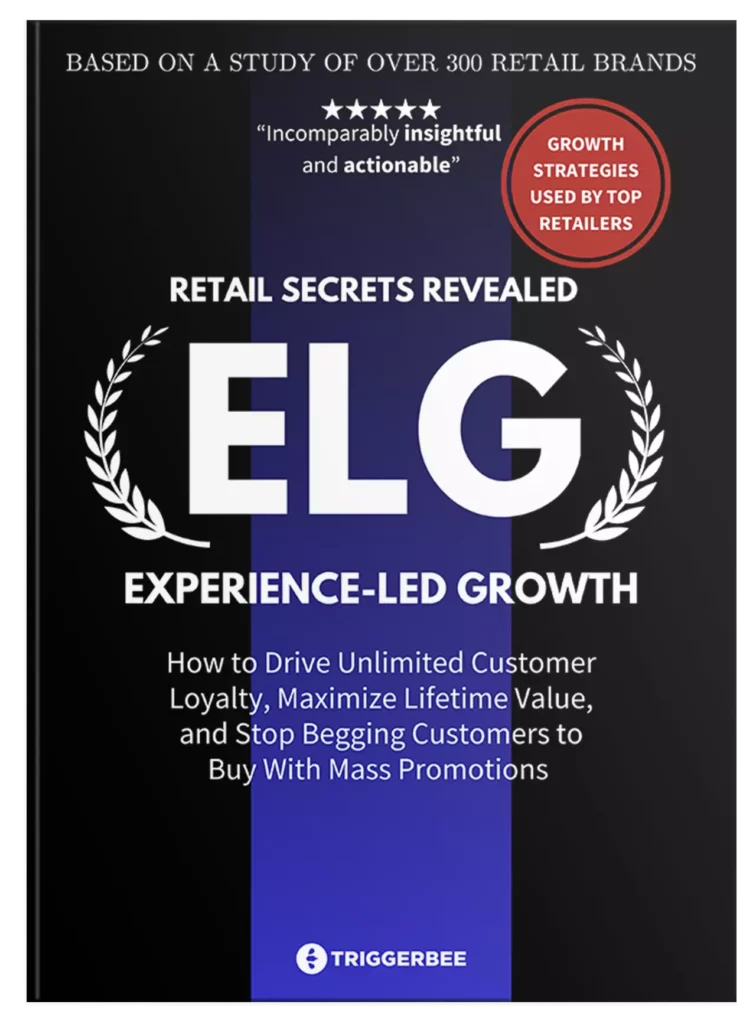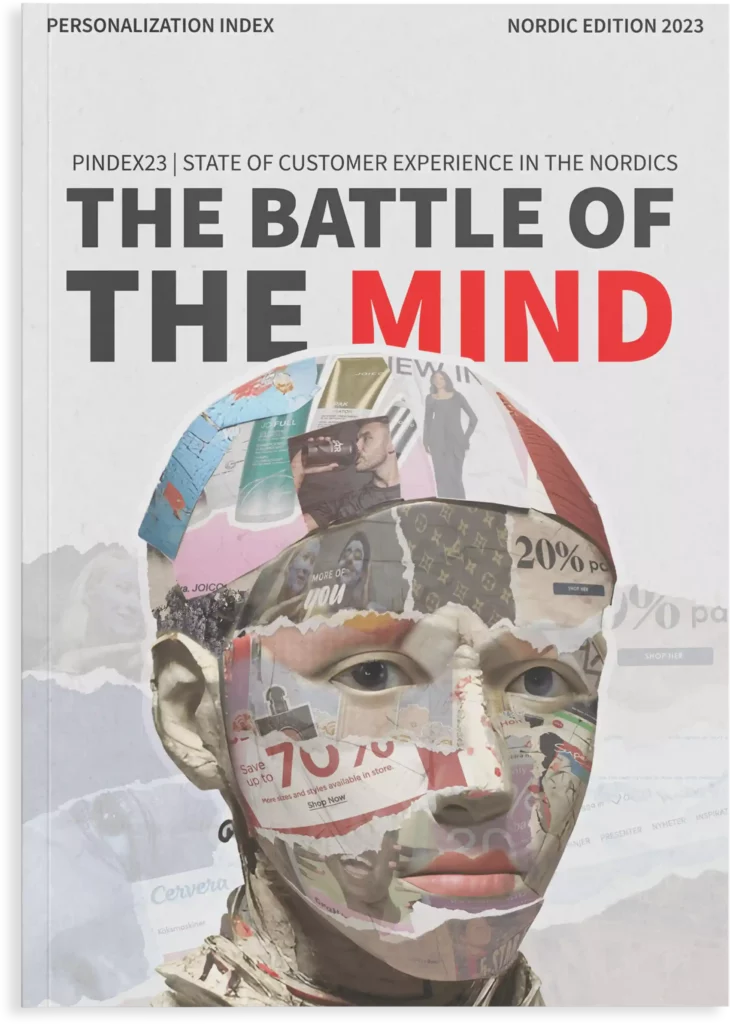In this post, you’re going to learn how to use some of the most effective sales promotions and discount strategies that will increase your e-commerce sales and grow your email list like crazy.
From flash sales to abandoned cart campaigns, gamification, to referral discounts, and personalized coupons, we’re covering it all.
All of these strategies should be strategically considered when making a customer experience strategy, in your acquisition strategy, and retention strategy.
- Flash sales
- Abandoned cart discounts
- BOGO deals
- Seasonal sales
- Mystery discounts
- Tiered discounts
- Newsletter discounts
- Pre-launch discounts
- Loyalty discounts
- Referral discounts
- Sitewide sales
- and many, many more.
Let’s dive right in.
The history of coupon codes
Coupons as we know them today go back as far as 1887 when Asa Candler was working hard to get people to try a glass of his newly purchased beverage, today known as Coca-Cola.
Asa Candler had just bought the Coca-Cola recipe from the pharmacist John Pemberton. As a firm believer in advertising, Candler came up with an innovative marketing strategy: offer hand-written vouchers to the public.

Each voucher entitled the owner to a free glass of coke, which at the time retailed for 5¢.
The result? Well…
Between 1894 and 1913, it is estimated that around 8.5 million free glasses were distributed to the American people.
But keep in mind that it took Coca-Cola 19 years to give out these coupons.
However, it wasn’t until the 1930s, after WWI, that coupons became widely used by retailers and other companies.
Supermarket chains were the first to adopt the discount coupon, and the discounts were so steep they made a loss at every purchase that was made.
But they were confident that the loss would be regained through the number of new customers acquired.
If we fast forward 110 years to today, coupons, discounts, and seasonal sales are now essential strategies for most retail brands.
And we’ve learned a ton about what works and what doesn’t in this century of discounting.
There is only one thing that sets a good sale apart from a mediocre one: Psychology.
The psychology of discounts
Most discount strategies tap into one or multiple cognitive biases that affect our decision-making:
- Anchoring bias. This bias refers to the human tendency of relying too much on the first piece of information given to us in a particular situation or for a particular topic. In the context of retail and e-commerce, it often refers to the way a sale is promoted. For example, if you are having a sitewide sale with most products discounted by 30%, and a select few products are discounted by 50%, you can choose to promote your sale by saying “Sitewide sale – Up to 50% Off!”. The value “50%” will then become the anchor for your promotion and will influence your customer’s decision-making.
- Scarcity bias. This bias refers to the tendency to place a higher value on things that are rare or in limited supply. For example, discounts and promotions like flash sales, and phrases like “limited time only” or “while supplies last” can create a sense of urgency that leads your customers to buy a product without giving it a second thought.
- Endowment effect. This bias occurs when people overvalue things they already own, simply because they own them. Personalized discounts can trigger this effect, because the discount code is given to you based on your purchase history or membership status.
- Framing effect. Framing refers to the way information is presented and is a very powerful way to influence decisions and behavior. Discounts can be framed as a percentage off (15% off), as an absolute amount ($15 off), or as a money-saving discount (Save $15 / Save 15%). Framing can also be used to highlight certain aspects of an item to make it more appealing to certain audiences, for example by using labels such as “Vegan”, “All-natural”, “Organic”, or “Eco friendly”.
Pros and cons of discounting
I know there are some people who won’t agree with me, but as long as your margins allow, the pros greatly overweigh the cons of discounting.
Discounts help you acquire new customers, give a reason for loyal customers to return, and they can help you reactivate customers who haven’t purchased in a while.
However, if you’re using static coupon codes you might be vulnerable to coupon hacking. If you are worried about customers guessing your coupon codes or if you have a history of customers who misuse coupons, consider generating unique coupon codes for an added layer of security.
Here’s the deal (see what I did there?):
There is really only one con to discounting, but it’s a pretty big one…
If you overuse discounts and sales, your customers will eventually get used to buying at a discount and learn that they don’t have to buy anything at full price.
Remember, your customers can keep their money in their pockets for longer than you can go without selling any items.
The only way to avoid this is to use discounts strategically and thoughtfully.
Now, let’s go straight to business and start talking about the strategies.
Flash sales
If you need to run a promotion, flash sales are a GREAT way to increase your sales and get rid of old stock.
⚡ Here’s how they work:
A flash sale is a sudden and unannounced sale with deeply discounted products, only available between 12-24 hours.
Huge events like the Superbowl and shopping holidays like Black Friday are perfect opportunities for a flash sale.
For example, Nastygal took advantage of the Superbowl and sent out this email:

Flash sales work because it taps into multiple psychological biases and principles:
- Scarcity
- Urgency
- Exclusivity
- Hindsight bias
In short: A flash sale will make your brain light up like a Christmas tree.
However, you don’t want to run flash sales every week. Keep it limited to major events or for slow periods where you need an injection of sales.
Here’s a final flash sales tip: Make sure your flash sale is worth the effort. If you continuously run a 10% discount deal for new customers, why would anyone rush to your site to buy for 15% off? If you run a flash sale, make sure you make it worth it for your customers.
Abandoned cart discounts
More than 70% of all carts are abandoned, and you can never get rid of abandoned carts completely. But you can easily recover 10-15% of abandoned carts by using behavioral segmentation in combination with well-timed exit intent popups, and cart recovery emails.
⚡ How Abandoned cart discounts work:
Give a discount to any website visitors who have visited the shopping cart, with products added to the cart, but who are about to leave the website without making a purchase.
The most common way of recovering abandoned carts is with abandoned cart emails. But there is one tactic that is way more effective and yields results before the customer has left your e-commerce store.
Let’s take a look at both types of cart recovery strategies:
Website cart recovery example
If you add an exit intent campaign to your checkout, you can recover 10-15% of all abandoned carts while your customers are still on your website. Just offer an extra discount or free shipping to persuade people to complete their purchase. It’s a very effective strategy, and a great compliment to abandoned cart emails.
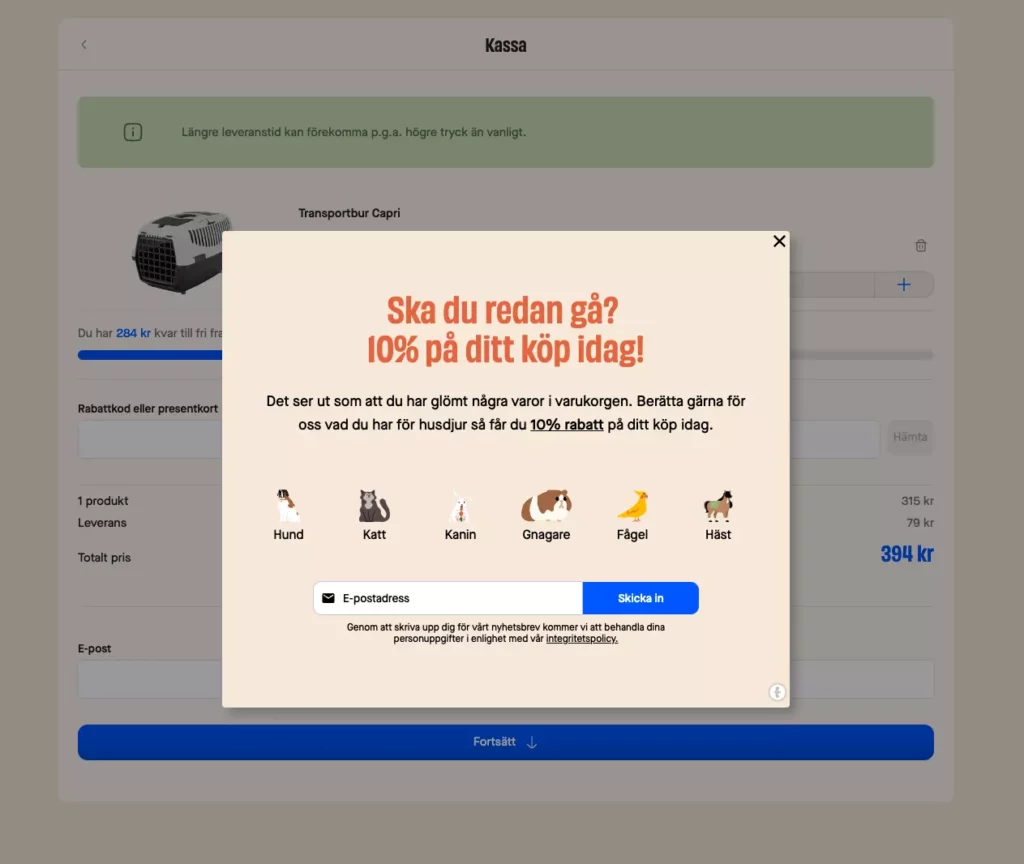
Swedish animal store Firstvet uses an exit intent in the checkout with a 10% discount to incentivize visitors who are about to abandon their purchase. The best part is that they are taking the opportunity to collect first-party data at the same time, which they can use to get to know their audience better, segmenting email campaigns, and running ads.
Cart recovery email
Cart recovery emails are very common these days, although our own research suggests that only 19% of Swedish retailers use abandoned cart emails.

Kappahl is a huge Swedish fashion retailer who sells clothing for men, women, and kids. In their abandoned cart email they do most things right. They include the products with were left in the cart, they keep the email short and sweet, the only thing missing is a time-limited offer.
Buy One Get One Free (BOGO) Deals
If there is one promotion strategy in retail that wields the power of a thousand salespeople, it’s ”Buy One Get One Free”.
⚡ Here’s how BOGO deals work:
Buy one get one-deals (BOGO) offers a full discount on a second item when a customer purchases the first item at full price.
They are super effective. In fact:
BOGO deals attract more customers compared to percentage discounts.
Here’s the best part:
This type of sales promotion taps into the psychological effect of framing.
You could run a promotion that says: 50% off
Or you can rephrase it and say “Buy one get one FREE”.
⚡ Here’s an example of a BOGO deal:

Behavioral economist Dan Ariely conducted an experiment where participants were given a choice between a free Hershey’s Kiss for 1 cent or a Lindt truffle for 26 cents and then observed the buying power.
Here’s a quote from Ariely’s blog:
“In one trial of one study we offered students a Lindt Truffle for 26 cents and a Hershey’s Kiss for 1 cent and observed the buying behavior: 40 percent went with the truffle and 40 percent with the Kiss. When we dropped the price of both chocolates by just 1 cent, we observed that suddenly 90 percent of participants opted for the free Kiss, even though the relative price between the two was the same. We concluded that FREE! is indeed a very powerful force.”
It’s all about how you describe your offer.
50% off is the same as “Buy One Get One Free”. And a 33% discount is the same as “Buy 3 pay for 2” or if following Ariely’s study, “Buy 3 Get One Free” (this rhymes!).
So the next time you think about running a 50% discount — maybe opt for “buy one get one free”?
Mystery discounts
Curiosity can dramatically increase your customer’s motivation to purchase.
⚡ Mystery discounts work like this:
Offer your customers a discount code, but don’t reveal the amount of the discount until they apply it at checkout.
It might sound weird but it is scientifically proven to work.
Mystery discounts tap into the psychological bias of curiosity, surprise, and excitement.
Curiosity is very powerful to use in retail sales. Here’s why:
If something sparks your interest you don’t actively think “Oh wow, I am now feeling curious about this”. Instead, you just follow your interest without giving it a second thought. You keep looking for more information until you are satisfied.
It works almost the same when used as a promotion strategy.
By not revealing the amount of the discount, you will effectively keep your customers on a “curiosity leash”. All they know is that they are entitled to a discount, but not how much.
You can do it using spin the wheel popups:
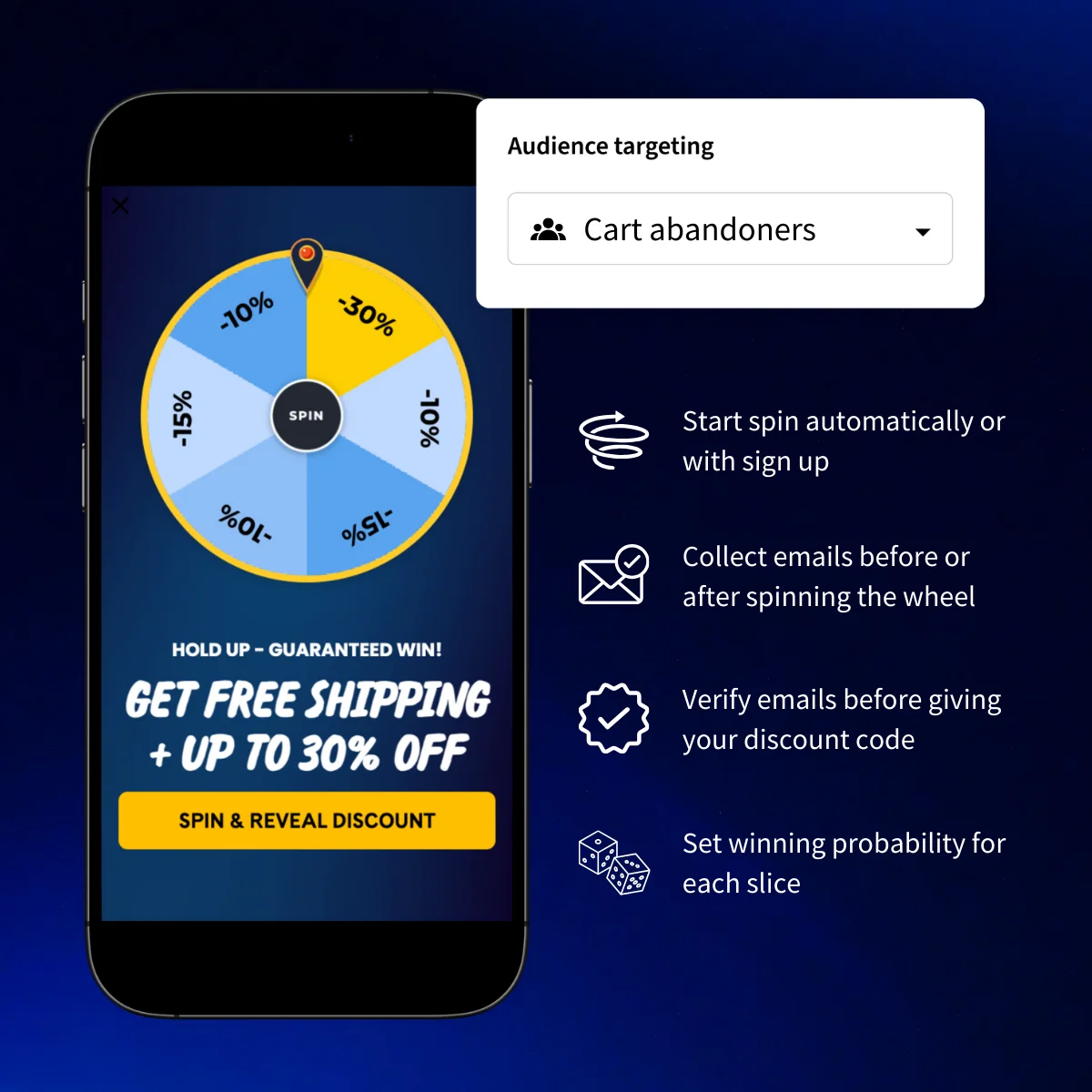
Or you can offer a free mystery box with a purchase over a certain amount:
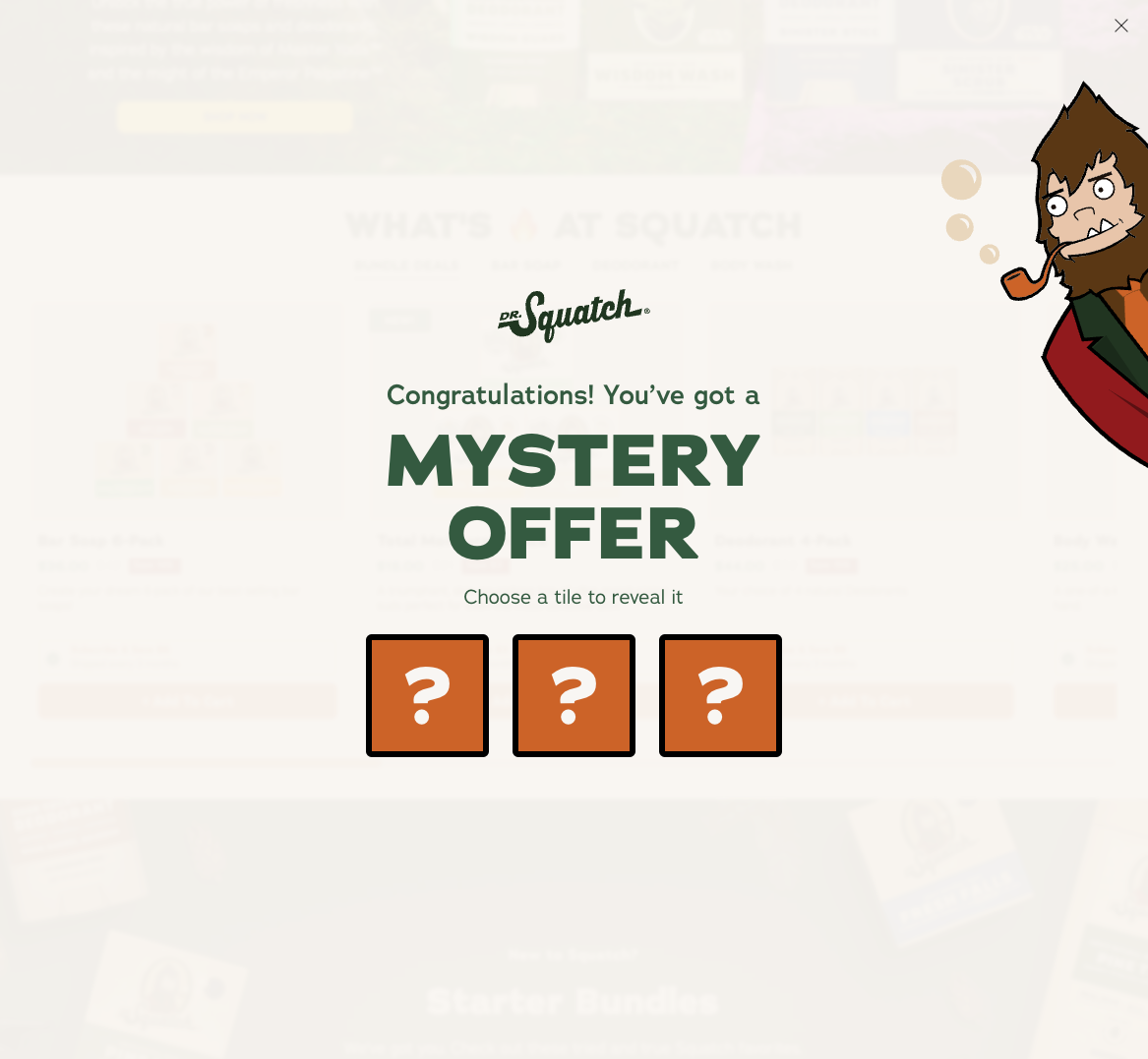
There is also a second psychological bias at play…
Loss aversion.
People are more motivated to avoid losses than to gain something of equal value. This bias is known to affect people’s decision-making, and once your customers see their discount they don’t want to lose it (if it amounts to a good deal).
Think about it:
Imagine walking into a store and one of the employees says “Hey, find some stuff you want to buy and I’ll give you a great discount once you get to the register.”
You don’t know how much of a discount you will get = Curiosity
Once you get the discount, you don’t want to just say no after you spent time choosing your items = Loss aversion.
Even companies like Dell use mystery discounts in their promotion strategy.

So if you think mystery discounts are not for you, think again.
Tiered discounts
If your go-to discount strategy is made up of flat offers like “10% off” or “15% off”, you’re going to love this strategy.
Tiered discounts are one of the best promotion strategies to drive up your average order value.
Here’s an example:
- Shop for $49 – Get 10% off
- Shop for $99 – Get 20% off
- Shop for $149 – Get 30% off
Shein distributes a tiered discount for new visitors to their website through this popup. It’s shown immediately, and lets visitors know what type of discount they can expect.
This strategy works especially well during intense shopping holidays like Black Friday (or Black Week), Christmas, or other seasonal events like President’s Day or the Superbowl.
⚡ Here are a few tips on how to run a tiered discount:
- Use small increments between each discount level to encourage higher spending.
- Discounts should be based on the total amount of the purchase.
- Match tiers with your average order value. Your minimum tier should be slightly above your AOV.
- Make even the lowest tier worth shopping for. Nobody feels excited about $5 off if they have to spend 10x that amount first.
- If your AOV is < $100 it’s worth testing percentage discounts vs dollar discounts.
- Keep your offer simple. If there is any form of complex logic involved your shoppers will leave and go somewhere else.
Tiered discounts are effective because they tap into the psychological bias of anchoring.
People tend to make decisions based on the first piece of information they receive.
If you have three tiers where 10% off is the minimum tier and 30% off is the highest tier…
You should promote your sale by mentioning the discount or saving from the highest tier in your marketing material.
Like this:
“Up to 30% off on selected items!”
Sacks Fifth Avenue which sells luxury clothing does exactly this in their tiered discounts:

As you can see, the lowest tier in their promotion gives you $100 off. The highest tier gives $300 off. A perfect example of how to draw shoppers in using anchoring.
Newsletter sign-up discounts
Here’s how it works:
Give your website visitors a 10-25% discount on their next purchase as a reward for signing up for your newsletter. Like this:
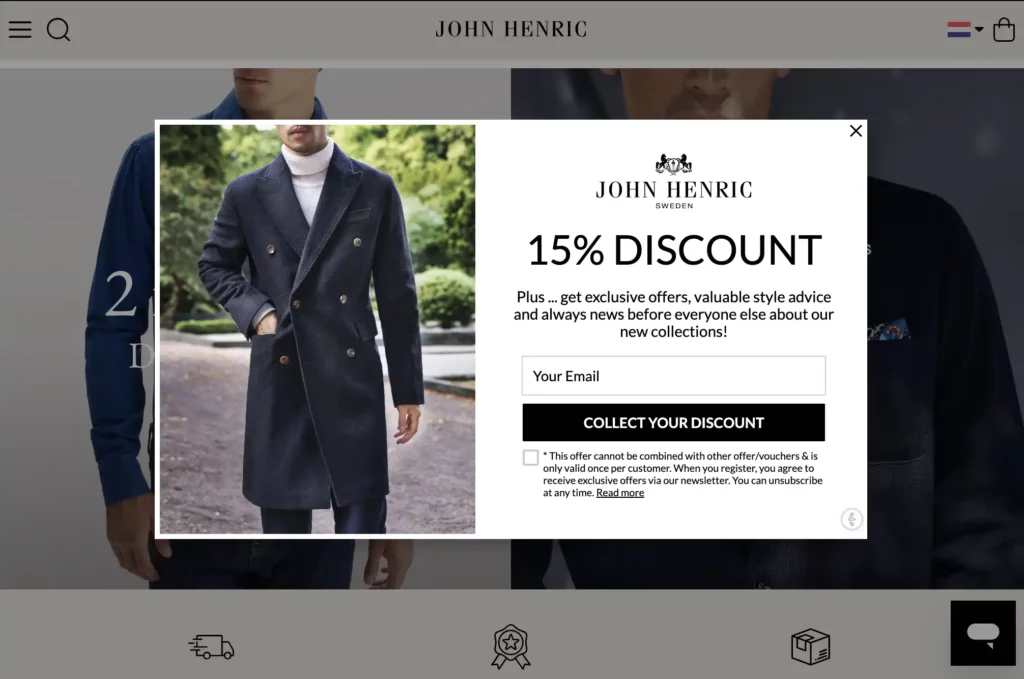
If you want to grow your email list FAST, use email subscription discounts.
It’s super simple and works like crazy.
The best part is that you can do it almost however you want. All you need is a great offer and make sure that your offer is understandable at a glance.
⚡ Here are a few tips on how to create the best email subscriber discount campaign:
- Don’t give away discounts to existing customers and subscribers. If you use Triggerbee, you can turn on email validation for all your campaigns with the click of a button.
- Target new or returning website visitors who have not yet signed up for your email list.
- Preferably use discounts over 19%. According to this study, discounts below 19% make your customers spend less while discounts above 19% increase overall spending.
- Write out the discount in the headline. Your website visitors are never fully focused on your website so you want to make sure that they can quickly understand what they will get by signing up for your newsletter.
- Don’t ask for both an email address and a phone number at the same time unless you want low conversion rates. Pick one or the other.
And that is all there is to it.
If you want high conversion rates for your email discount campaign, the discount rate and targeting are the two most important things.
Pre-launch discounts
When you are releasing a new product in your e-commerce store, you need to use pre-launch discounts.
Pre-launch discounts help you hype up the launch and generate a list of potential customers waving their credit cards in front of their phones.
⚡ Here’s a real-life example of a pre-launch discount:

Bubbleroom is one of the largest fashion stores for young women in the Nordics.
They used a pre-launch campaign to build up hype for a fashion collaboration with influencer Lovisa “Lojsan” Wallin. About 2 weeks before the big launch, they used Triggerbee to build and publish a pre-launch popup to capture anonymous website visitors. They also built and published an embedded form on a landing page targeted to their members.
The result?
The pre-launch popup had a stunning 40% conversion rate. And the collection sold out in less than an hour when it launched.

Pretty nice.
Here are a few tips to make the most out of your next pre-launch discount campaign:
- Don’t start too early. Let your campaign run between 1-3 weeks for best results. If the promotion starts too early, your customers will forget about it and you will lose momentum.
- Always use a countdown timer. Timers add a sense of urgency and give your customers a feeling that the date it’s counting down to is important.
- Give away discounts or early access. Discounts will always be the king of retail promotion strategies, but early access to hyped promotions is the queen.
Loyalty discounts
Loyalty programs are the secret sauce used by many of the world’s biggest retailers.
There are countless studies on the effectiveness of loyalty programs.
And according to this study, the primary drivers of what makes loyalty programs work are the economic benefits such as rewards and discounts.
⚡ There are a lot of different types of loyalty program discounts:
- Discount reminders
- Spend-based discounts
- Birthday discounts
- Personal discounts
- Permanent discounts based on tiers
All of these discount types are very effective at driving repeat purchases and boosting your average order value.
But let’s go through the three most common and effective discount strategies.
1. Discount reminders
A discount reminder is exactly what it sounds like. Remind your customers to use a discount given to them.
Here’s how it looks:

KICKS is the biggest beauty retailer in the Nordics, and they show a popup to club members who have received a discount but have not yet used it.
If you have a loyalty program and haven’t tried reminding your customers of their unused discount codes, the results might surprise you.
This discount strategy usually has a CTR between 30 – 60% across all retail categories and a very high conversion rate.
Sounds like it’s worth a try.
2. Birthday discounts
Birthday discounts are effective because 1) they are underutilized by most brands, and 2) they are personal and highly relevant.
Here’s how it looks:

As you can imagine the results are pretty mind-blowing.
Clickthrough rates usually end up between the 45 – 60% range across all retail categories.
3. Spend-based discounts
Your customers expect to be rewarded when they buy from you. Either in the form of points that can be redeemed in the future, or with an immediate discount as a special treatment.
Here’s one example of how you can do it:

The trick here is to know when to give away a percentage discount or dollar amount.
If your average order value is lower than <$100, assume that a specific dollar amount will give you a higher conversion rate compared to a percentage discount.
New customer discounts
If you want to acquire customers cheaply, you should consider shifting some of your marketing budget from ads to discounts. The results might surprise you.
⚡ Here’s how new customer discounts work:
Give new customers a discount before they make their first purchase.

Here’s the truth:
Customer acquisition is a budget game. If you are competing against brands with deeper pockets than you, they have the upper hand.
But you can get the upper hand by knowing how to use your marketing budget wisely.
The brand with the most money will win the advertising game 9 times out of 10.
Most e-commerce brands use a 10-15% discount to acquire new customers. But science says that any discount below 19% actually reduces overall spending.
Assuming that your margins are not extremely low, you should consider offering new customers a minimum of 20% off for their first purchase.
It’s aggressive. But it will help you accelerate your growth and sales pretty quickly.
You don’t have to increase your ad spending for this to work. Because if you target a popup to all website visitors who have never made a purchase, you will grow your email list and sales at the same time.
Here’s the most important part:
When giving out a high discount to new customers, make sure you use popup software that can validate emails and only show the discount to new subscribers and customers.
Referral discounts
According to this Nielsen study, 86% of people trust recommendations from people they know more than any other source.
That is why referral discounts are one of the most effective ways to drive revenue and grow your email list.
⚡ There are two types of referral discounts:
One-sided referral discounts
One-sided referral discounts only reward a discount code to the person who is referring a friend. These can work, but they are not as effective as double-sided referral discounts.
Double-sided referral discounts
Double-sided referral discounts reward a discount code to both the person referring someone else and the person being referred. Double-sided rewards are hands down the most effective referral strategy and the top choice by companies like Allbirds, HUEL, ASOS, William Painter, Tesla, and many more.
Here are three awesome examples of referral discounts:
How ASOS uses referral discounts
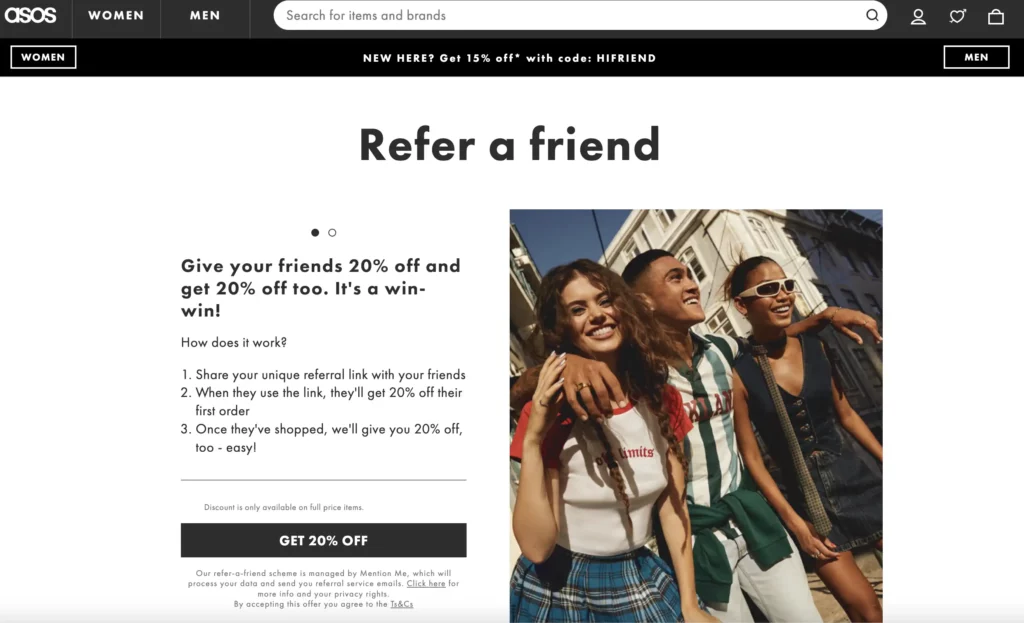
ASOS referral program looks great, and the rules are simple. Give a friend a 20% discount on their next purchase. When they’ve shopped, you get a 20% referral discount as a reward.
How Allbirds uses referral discounts
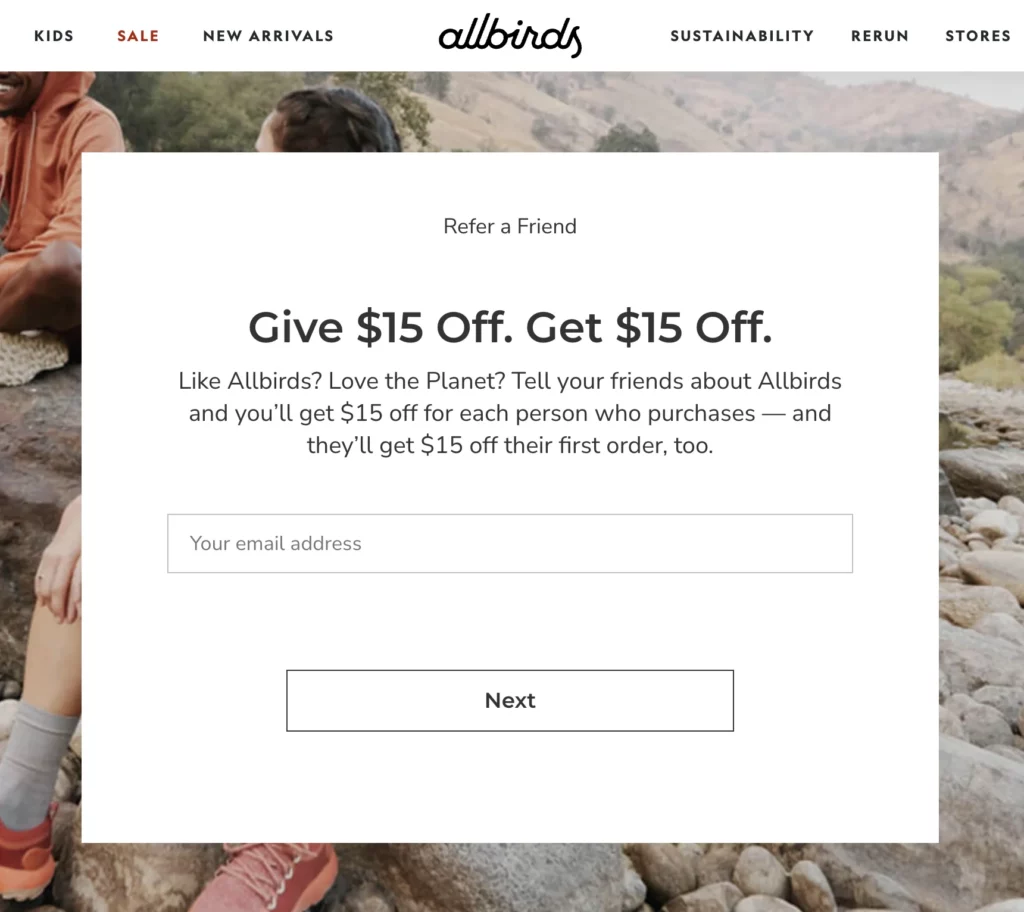
Allbirds chose to give away cash instead of a percentage discount. They are also a bit more aggressive with their referral discount rewards. You get $15 off for every person you refer who makes a purchase. The costs can quickly add up, and if you want to run a similar program, you need to make sure your referral revenue covers the costs.
How William Painter uses referral discounts

William Painter gives a $50 cash reward to you, and a $50 referral discount for a referred friend who makes a purchase. Your cash reward is given to you after your friend has purchased a pair of glasses. It’s very aggressive, but I can imagine it works very well for them.
Seasonal sales and promotions
Black Friday, Valentine’s, and Christmas are all seasonal holidays that drive a lot of website traffic and purchases.
If you’re a retail or e-commerce marketer, you have probably spent a lot of time preparing for seasonal events like Black Friday and Christmas.
⚡Here’s how a seasonal sale work:
Offer a discount or sitewide sale before and during a seasonal event like President’s day, Valentine’s, Christmas, Halloween, or any of the other seasonal events throughout the year.
Here are a few tips that apply to all seasonal and holiday promotions:
- Always display the last order date for guaranteed delivery. This will reduce disappointments and frustrated customers. Like this:

- Promote gift cards as an alternative to products. A gift card might not be a perfect gift, but it’s great for last-minute shoppers.

- Offer free shipping. Free shipping is expected by your audience and will increase your conversion rate by a big percentage.

The most effective promotion for seasonal promotions are:
Pre-launch promotions
One of the best marketing ideas for retail holidays is pre-launch promotions. The main benefit is that you collect emails from people who are actively looking to buy stuff from you.
Pre-launch promotions are especially effective in the weeks leading up to huge events like Valentine’s, Thanksgiving, Halloween, Black Friday, and Christmas.
⚡ Here’s how pre-launch promotions work:
Pre-launch campaigns are marketing campaigns that companies run in the period leading up to the launch of a new product, a big sale, or a huge event. The goal of a pre-launch campaign is to create a sense of urgency and encourage customers to be among the first to buy your new product or get access to a sale before it’s publicly available. Pre-launch campaigns can take many forms, but most create a signup form to capture emails (or SMS numbers) of people who are interested in buying from you.
In fact, pre-launch campaigns are so effective that they can increase your signup conversion rate by up to 60%.

One of our customers ran an A/B test for a pre-launch campaign in the weeks leading up to Black Friday. In the original version, the message emphasized that Black Week was coming up. In the challenging version, they emphasized that you could “Shop before everyone else”.
The most impressive part? The copy is exactly the same but the visual hierarchy is different. By changing the visual hierarchy, the offer is perceived completely differently.
The small things matter.
Pre-launch extra tip:
Make sure you always use two variations of the same campaign. One variation targeted to anonymous visitors with an email signup form and the other variation targeted to customers with only a button. This ensures your campaign is relevant to your two largest audience segments.
Gift guides
Everyone struggles with finding the perfect gift. Creating gift guides is the perfect way to help your customers with suggestions they might not have thought of before.
And the best part is that you can create one guide, then customize it for every holiday and special occasion.
Not only will it help you SEO-wise, but conversion-wise as well.
Here are two gift guide examples from Nordstrom and Sephora.
Nordstroms valentines gift guide

Nordstroms promotes its gift guide on its homepage, and it shows links to different gift categories to help its visitors discover new products for everyone.
Sephora gift finder

Sephora uses a quiz to help you find the perfect gift. A quiz can be a great way to both engage your audience and help them out at the same time.
Calendar promotions
Any event that stretches over more than 3 days is a potential “calendar” promotion candidate.
⚡ The calendar concept is super simple and easy to implement. Here’s how it works:
A calendar refers to a campaign that changes each day during a multi-day holiday or event, similar to an advent calendar that you use to count down to Christmas.
Here are two ways to use calendar promotions:
Pre-launch your holiday calendar with an inline or popup form.

Run a daily deal for the duration of the seasonal event.

Simple but effective. The results from a calendar promotion will blow your mind.
The average conversion rate for the calendar promotion signup form is between 50-80%.
And the average click-through rate for daily promotions in a calendar format is ~70-90%.
Incredible.
Category discounts
Most online stores don’t use sitewide discounts more than a few times each year.
However, most online stores almost always have something on sale. And 9 times out of 10 it’s a category sale.
⚡ There are mainly two ways to run a category sale:
Brand sales
When items from certain brands are on sale — i.e. “20% off Levi’s jeans”

Product category sale
When you discount all items in a specific category — i.e. “20% off all spring dresses”.

Sitewide sales
A sitewide sale is a promotion strategy where every single product in your e-commerce store is discounted by a certain amount.
It’s a very aggressive sales promotion strategy, and will not work for brands with low margins.
Well-executed sitewide sales can increase your online sales very fast.
⚡ Here are a few things you need to consider before running a sitewide sale:
- Which audience are you targeting? You can offer a sitewide sale for only members or email subscribers, or all visitors regardless of customer status or purchase history.
- Time limit. Set a fixed time limit for your sitewide sale. Even if your overall sales increase, you need to check that your most important e-commerce metrics like overall spending, average order value, and revenue per session don’t take a dive.
- Discount level. Do your margins support a 30% or 40% sitewide sale? For a sitewide sale to be worth checking out it needs to be a great deal.
Because sitewide sales are so aggressive, most brands try to tie it to a holiday or event in order to have a reason for running the sale. But you don’t always need to rely on external events to motivate running a sitewide sale…
Offering a sitewide sale to subscribers or customers can be reason enough.
Here are three examples of sitewide sales from Fashion Nova, Casper, and MVMT:
How Fashion Nova uses sitewide sales

Fashion nova targets everyone in their audience for their sitewide sale. Note that they use a top banner, just below their navigation, with a countdown timer to mark the end of the sale and create a sense of urgency. They’re smart.
How Casper uses sitewide sales

Casper uses audience targeting to run a subscriber exclusive sitewide sale. They ran this just before Valentine’s, meaning during a quiet period. Instead of running an early Valentine’s sale, they decided to go for the targeted sale instead.
How MVMT uses sitewide sales

MVMT took advantage of Valentine’s Day to run a sitewide sale. This gives them a reason that almost always increases conversion rates. Having a reason for doing what you do can help you build more trust with your audience.
Clearance promotions and sales
All e-commerce brands have unsold inventory and it can quickly become a huge issue.
You need to have a strategy for getting rid of your unsold products.
For example…
Fashion giant H&M disclosed that they had accumulated over $4 billion in unsold inventory in a quarterly report from 2018.
Not great.
⚡ Here’s how clearance sales work:
A clearance sale is when a retailer offers discounts on items that they want to clear out of their inventory to make room for new products.
Visit the website of any large fashion retailer and you’ll most likely see an outlet section. The “outlet” is just a fancier word for clearance sale. But rebranding clearance to “Outlet” is a smart way to have an ongoing clearance sale without it affecting your brand.
Unsold inventory is a huge liability if you don’t know how to get rid of it. But you can turn it into an asset by selling your unsold stock under an “Outlet” section or even build a new low-price brand.
Here are a few examples of clearance sales strategies:
Kohl’s clearance sale

Kohl’s promotes their clearance sale directly on their homepage. This leads to a lot of visibility, and they are helpful in guiding their visitors to different price points.
ASOS clearance sale

ASOS takes the opportunity to promote their outlet section that is filled with products and gifts for Valentine’s, items similar to what some celebrities wore on the Grammy’s, and much more.
Zalando built a sub-brand for their clearance sales

Zalando is huge. With thousands and thousands of products, they could easily run daily deals with new offers every day. But instead, they chose to build a sub-brand called Lounge by Zalando to sell unsold inventory from their main site. Pretty smart!
Boozt uses a sub-brand for their outlet sales

Swedish fashion giant Boozt built a separate sub-brand called Booztlet for selling unsold inventory. It allows them to use different messaging that can push deeply discounted items without affecting their main brand.
Personalized discounts
A personalized discount is a discount code given to you based on your previous spending habits, customer status, or purchases.
They are created and distributed to specific customer segments using customer data such as purchases, total spending, or customer status as criteria for the discount level.
⚡Here’s a very basic example of how personalized discounts work:
- Regular customer (1-5 purchases / year) = 10% discount
- Loyal customer (5-10 purchases / year) = 15% discount
- Irregular customer (0-3 purchases / year) = 25% discount
- Lost customer (5 purchases last 24 months / 0 purchases last 12 months) = 20% discount
The above examples of different customer segments are based on number of purchases. These segments are usually created in a customer data platform like Segment, an e-commerce marketing platform like Klaviyo, or in loyalty management software like Voyado. We chose to reward irregular and lost customers more than loyal customers because they need to be reactivated, and they often need a bigger push compared to those who return without needing an incentive.
Personalized discounts are usually distributed through email, SMS messages, and on the website.
Most brands only use email or SMS to deliver their discounts. But do not forget to use your website to distribute your discount codes. Your website is the place where your customers buy, and giving out a discount code closer to the point of conversion is always a good idea.
If you have a ~30% open rate on your email campaigns… that means 70% of the people on your list did not see your discount. One of the best ways to get more people to see your discount is to publish a discount popup on your website targeted to the same audience.
You can use Triggerbee to show a personalized discount code to specific audiences and lists in Klaviyo, Mailchimp, and more.
Here are 5 different types of personalized discounts:
1. VIP discounts

VIP Discounts are discount codes distributed to your most loyal customers, and offer them a great reason to return. Contrary to most advice, VIP discounts don’t need to be large if the customer is already loyal to your brand and returns without an incentive. If you use VIP discounts on your website, you can expect a ~40-70% discount click-to-copy rate and a very high usage rate.
2. Winback or Re-activation discounts
Reactivation discounts or win-back promotions are great for reviving and reactivating customers who don’t regularly buy with you. Treat these customers with extra care, especially if they have not been opening your emails. One of the best ways to reach churned customers is to target them with a reactivation popup on your website so that once they return they get a special offer.
3. Next purchase discounts
Next purchase-discounts are not really what you think about when you hear personalized discounts, but they are personal because you can give out a different discount code based on the purchase value. They are also a very effective tool to increase your customer retention. You can distribute next purchase-discounts in your confirmation emails, on the confirmation page, and straight on your website using personalized campaigns targeted to recent buyers. Just make sure you use a popup tool that can target customers that recently bought or specific segments from your e-commerce marketing platform.
4. Birthday discounts
What’s more personal than celebrating a customer’s birthday? It is one of the few strategies with almost guaranteed results. Send out a birthday email with a 15-25% discount and show a popup with a discount code they can click to copy on your website for maximum engagement. These popups usually have a click-to-copy rate of about 90% and very high conversion rates.
5. Unused discount reminders

Discount codes are given out for a reason. Even if you make losses on some discount campaigns, they keep customers loyal and coming back. Discount reminders can be considered a secret weapon. Most brands send out reminders via email, but the real power of a discount reminder is when it’s used on the website. Showing a popup with the message “You still haven’t used your 10% discount” on your website, is extremely powerful because the customer doesn’t want to lose something they already “own”. And if they are on your website, they are closer to the conversion compared to if they are receiving a discount reminder in their inbox.
Sending and showing personalized discounts based on customer data helps you connect with your customers in a way that most other promotions cannot.
Quantity discounts
Quantity discounts are great for increasing your average order value, and you can get very creative with how you structure these discounts.
They are similar to tiered discounts in that you get a better price the more you spend. The big difference is that quantity discounts usually have a fixed price for a fixed amount of items, i.e. “buy three pay $10 each, buy 5 pay $9 each”.
Here are the two most common variations of quantity discounts:
Bundled quantity discounts.
In short, the more you buy the less it costs. Use bundles to incentivize customers to buy more of the same product. This is perfect if you sell products that needs refilling or where many of the same product can bring more value, like beauty products, underwear, or sports products. Bundle discounts usually have fixed prices per item and are sold in fixed quantities:

Subscription discounts
Subscription discounts are a variation of a quantity discount because you purchase more than one product with regular payments every 1, 3, or 6 months. Subscriptions are a great way to keep customers locked in and guarantee revenue for a fixed period of time. If you’re a fan of direct-to-consumer (DTC) brands, take note that subscriptions are very trendy right now. Here’s how Native and Flutterhabit uses subscriptions:


Gift with purchase-deals
In the early 2000s, I remember getting a phone call from a salesperson who sold magazine subscriptions. I didn’t want the subscription, but when he offered me a free pair of headphones if I subscribed for 12 months I accepted the deal.
I never read the magazine, but I really enjoyed the headphones.
Free gift-with-purchase deals are a great way to give doubting customers a reason to make a purchase in your e-commerce store.
⚡ Here’s how they work:
Give a free gift in the form of a sample product or accessory when a customer purchases a specific product or meets a certain spending threshold.
Sephora and Nordstroms both use free gifts as a promotion strategy, and they partner up with luxury brands to give any doubting customer a good reason to buy now.

Sephora partners up with brands like Fenty and Olaplex to give away accessories and beauty products in trial sizes.

Nordstroms gives away free samples of perfume and scented candles from brands like Neom, Esteé Lauder, and many more when you buy a product from the same brands. They also label the products that come with a gift for increased visibility.
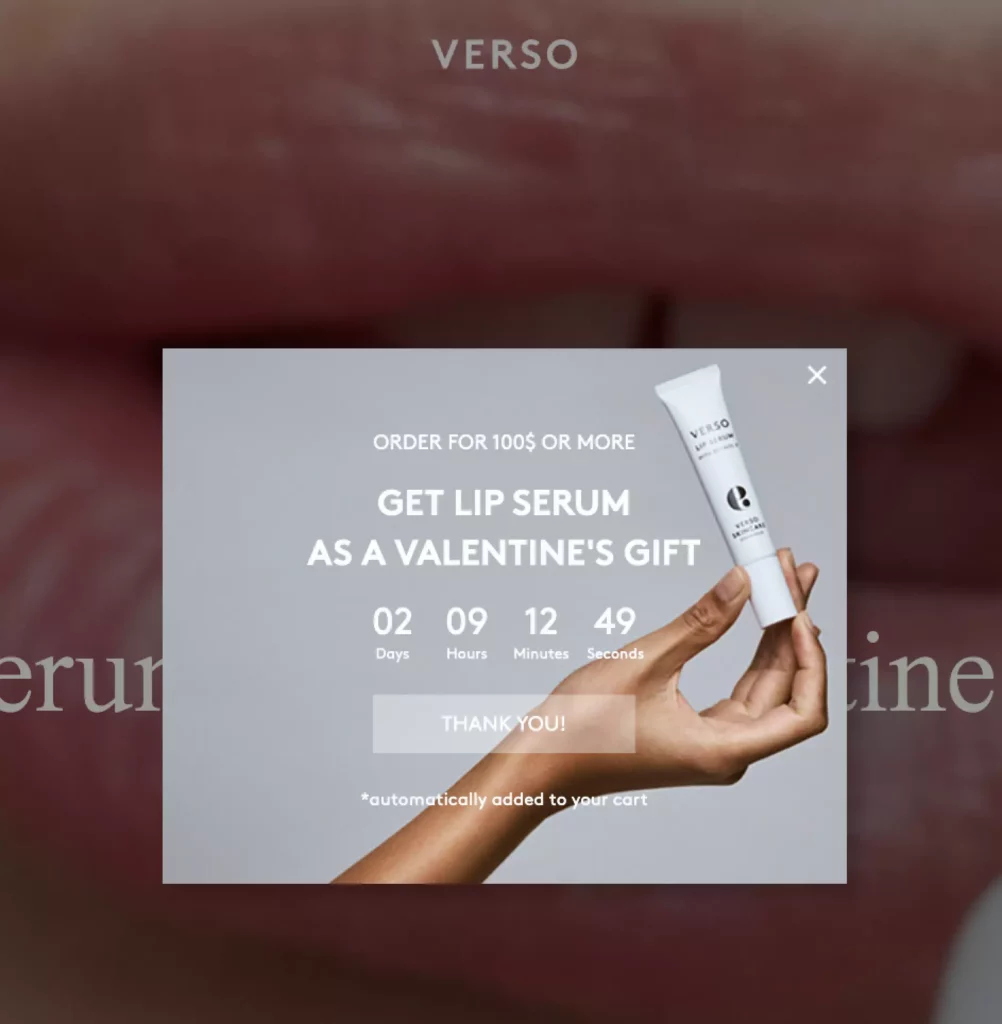
And beauty brand Verso offers a free gift with purchase as a valentine’s deal through a popup on their website.
Weekly discounts
Weekly deals give your customers a sense of urgency and can help you improve your customer retention as well.
If your customers see that you make a habit of offering weekly specials, like their favorite grocery stores, they are more likely to return to your store to see if anything they are interested in is on sale for the week.
Hosting regular weekly deals also means you need to distribute them regularly. For example, you can send out a preparation email that shows the deals for the coming week on Sundays.
You should also announce your weekly deals on your website with a popup, callout, or banner.
If you’re using Triggerbee, you can schedule your weekly promotions months in advance.
⚡ Here are two examples of brands using weekly deals:
Webhallen is a Swedish electronics store selling everything from vacuum cleaners to gaming computers. They use weekly deals to get customers to come back regularly and find deals from their favorite brands.

Philip Stein sells premium watches, and they discount a limited number of products by up to 50%.

Short-term deals and discounts
Short-term promotions like daily deals or weekend deals are a great way to increase customer retention and give your customers a reason to check in regularly. It’s also a great strategy for holiday sales if the holiday event spans multiple days.
For example, Black week is the perfect time to run daily deals. And for Christmas, you can use a calendar promotion strategy to inform about new products and daily deals.
⚡ Here are some examples of daily and weekend deals:
Daily deals
Daily deals work best if you have enough products to offer something new every day.
Daily deals are also a great strategy to use for the major holidays and shopping events like Black Week or Christmas where you can use calendars to distribute your daily deals.
Bubbleroom uses a daily deal strategy during Black week.
Nordic Nest uses the occasional daily deal for certain product categories.
Amazon is “the everything store”, and they have more than enough products to cycle through for new daily deals every day. They have a dedicated landing page for their daily deals, and it looks like this:
{Bild på amazon daily deals}.
Weekend deals
Weekend deals are a great substitute for daily deals. You don’t need a large number of products and you can discount specific categories that normally don’t sell that well.
Here is an example of how you can promote weekend deals on your website: 
Nordic Nest is an interior design store in Sweden. Their products are normally quite expensive and their weekend deals are great opportunities for their customers to find bargains.
Minimum purchase discounts
Free shipping and free gifts with purchase deals usually require a minimum purchase amount.
Minimum purchase discounts can be great for increasing your overall store spend and average order value. Not only does it nudge customers to spend more, but it gives you a good reason to offer upsells (compared to upselling just for the sake of it).
Here’s how Under Armour and Banana Republic use free shipping as an incentive to get customers to buy more:


Special group discounts
Special group discounts can help you to build trust and loyalty while showing appreciation for certain members of your audience.
Depending on your brand and which products you sell, there are a lot of special groups to whom you can give discounts:
- Seniors
- Kids
- Veterans
- Healthcare workers
- First-responders
- Teachers
Just make sure your brand and products are aligned with the cause you want to support.
Most companies have some special group discounts. Especially large brands that want to show their support and enable everyone to shop with them.
Adidas gives out a 30% discount online and an additional 20% discount in outlet stores to all medical professionals, first responders, nurses, military members, and teachers:

Synoptik is a Swedish eyewear company with its own spin on the special group discount. Instead of giving out a discount for special groups, they give your age as a discount. This campaign has resulted in huge awareness for the brand and essentially covers its full audience while rewarding seniors the most.
Summary
There are so many ways to give your customers a discount. You can give them in the form of free products, percentage discounts, or absolute amounts. Some of the most effective strategies, that our customers have used to sell billions worth of goods, are discount reminders targeted to members in a loyalty program, abandoned cart popups with 10-20% discounts, and pre-launch discounts.
Which strategy you choose to use is up to you, but don’t forget to test both your discount format (percentage, absolute, 3 for 2, etc) and your messaging. Just because Fashion Nova can run frequent sitewide discounts doesn’t mean you can do the same.
Hope you got some value from this post, and that you learned something new. Good luck!
